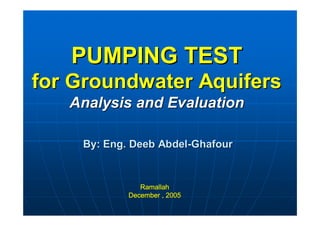The document discusses a course on analyzing pumping tests for groundwater aquifers. The course aims to teach participants how to determine aquifer properties through pumping tests. It covers key concepts like drawdown, specific capacity, and transmissivity. Participants will learn how to plan and optimize pumping tests, apply analytical techniques to interpret test data, and use software to analyze projects. The document provides an overview of the topics that will be covered in the course sessions, including aquifer conditions, equations for flow to wells, and methods for analyzing pumping test results.











![1212
Hydraulic PropertiesHydraulic Properties
Hydraulic Conductivity (K)Hydraulic Conductivity (K)
This property is a constant of proportionality that describes flThis property is a constant of proportionality that describes fluiduid
flow through a porous media. (flow through a porous media. (K)K) is a function of the permeabilityis a function of the permeability
of the media and of the physical properties of the fluid, and isof the media and of the physical properties of the fluid, and is
generally considered appropriate for evaluation of aquifergenerally considered appropriate for evaluation of aquifer
properties.properties.
DarcyDarcy’’s Law:s Law: states that the rate of flow through a porous medium isstates that the rate of flow through a porous medium is
proportional to the loss of head, and inversely proportional toproportional to the loss of head, and inversely proportional to thethe
length of the flow path, orlength of the flow path, or
v = K (dh/dl)v = K (dh/dl)
where,where,
v = Q/A, which is the specific discharge, or Darcy velocity,v = Q/A, which is the specific discharge, or Darcy velocity,
(length/time).(length/time).
Q = the volume rate of flow (length3/time).Q = the volume rate of flow (length3/time).
A = the cross sectional area normal to flow direction (length2).A = the cross sectional area normal to flow direction (length2).
dh/dl = aquifer hydraulic gradient (dimensionless) and,dh/dl = aquifer hydraulic gradient (dimensionless) and,
K = hydraulic conductivity (length/time).K = hydraulic conductivity (length/time). ]]](https://image.slidesharecdn.com/pumpingtest-150610085542-lva1-app6892/85/Pumping-test-12-320.jpg)
![1313
Hydraulic PropertiesHydraulic Properties
Specific Storage (Ss)Specific Storage (Ss)
Volume of water released from storage from a unitVolume of water released from storage from a unit
volume of aquifer per unit decline in hydraulicvolume of aquifer per unit decline in hydraulic
head. [1/L]head. [1/L]
Specific Yield (Sy)Specific Yield (Sy) is the volume of water yieldis the volume of water yield
by gravity drainage to the volume of theby gravity drainage to the volume of the
aquifer. The specific yield is dimensionlessaquifer. The specific yield is dimensionless
and typically ranges from 0.01 to 0.3.and typically ranges from 0.01 to 0.3.
Storativity (S)Storativity (S)
The storativity of a confined aquifer is theThe storativity of a confined aquifer is the
volume of water released from storage pervolume of water released from storage per
unit surface area per unit change in head.unit surface area per unit change in head.
The storativity is dimensionless andThe storativity is dimensionless and
typically ranges from 5x10typically ranges from 5x10--55
to 5x10to 5x10--33
..
S=Ss*BS=Ss*B
Transmissivity (T)Transmissivity (T)
The product of hydraulic conductivity and AquiferThe product of hydraulic conductivity and Aquifer](https://image.slidesharecdn.com/pumpingtest-150610085542-lva1-app6892/85/Pumping-test-13-320.jpg)










![2424
Before you startBefore you start……..ConCon’’tt
Determine the nearby wells that will beDetermine the nearby wells that will be
used during the test if itused during the test if it’’s likely they wills likely they will
be affected, this well depends onbe affected, this well depends on Radius ofRadius of
Influence.Influence. The following equation can beThe following equation can be
used to determine the radius of influenceused to determine the radius of influence
(R(Roo):):
RRoo =[(2.25 x T x t /S)] 1/2=[(2.25 x T x t /S)] 1/2
This equation can be applied for a pumpingThis equation can be applied for a pumping
well in a confined aquiferwell in a confined aquifer](https://image.slidesharecdn.com/pumpingtest-150610085542-lva1-app6892/85/Pumping-test-24-320.jpg)




















































![7777
The Hantush and Jacob (1955) solution for leaky aquiferThe Hantush and Jacob (1955) solution for leaky aquifer
presents the following equations:presents the following equations:
s=(Q/4s=(Q/4ππT)W [T)W [u,ru,r/B]/B] →→ TT =(Q/4=(Q/4ππs)Ws)W [[u,ru,r/B]/B]
wherewhere u= ru= r22
S/4TtS/4Tt →→ S=4Tut/rS=4Tut/r22
W [W [u,ru,r/B]: is the well function for leaky confined aquifer/B]: is the well function for leaky confined aquifer
B: Is the leakage factor given asB: Is the leakage factor given as
KK’’=[Tb=[Tb’’(r/B)(r/B)22
]/r]/r22
KK’’ is the vertical hydraulic conductivity of confining bedis the vertical hydraulic conductivity of confining bed
(aquitard) (L/t)(aquitard) (L/t)
bb’’ is the thickness of aquitard (L)is the thickness of aquitard (L)
B is the leakage factor, (TbB is the leakage factor, (Tb’’/K/K’’))1/21/2](https://image.slidesharecdn.com/pumpingtest-150610085542-lva1-app6892/85/Pumping-test-77-320.jpg)






















![100100
Residual DrawdownResidual Drawdown ss’’=s+s=s+srecrec
The above drawdown components areThe above drawdown components are
expressed with Theis equation as:expressed with Theis equation as:
ss’’=(+Q/4=(+Q/4ππT)(W(uT)(W(u) +() +(–– Q/4Q/4ππT(W(uT(W(u’’))))
ss’’=(Q/4=(Q/4ππT)[W(uT)[W(u)) ––((W(uW(u’’)])]
WhereWhere
u=(ru=(r22S)/4Tt and uS)/4Tt and u’’=(r=(r22S)/4TtS)/4Tt’’
t is time since pumping startedt is time since pumping started
tt’’ is time since pumping stoppedis time since pumping stopped
When u is less than 0.01, TheisWhen u is less than 0.01, Theis eqeq can becan be
simplified by Jacob and Coopersimplified by Jacob and Cooper eqeq as:as:](https://image.slidesharecdn.com/pumpingtest-150610085542-lva1-app6892/85/Pumping-test-100-320.jpg)







